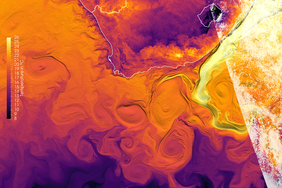First emphasized at the WCRP World Modelling Summit for Climate Prediction in 2008, 10 years ago Mitchell et al. (2012) reformulated a “grand challenge” for the longer term [...] to develop global climate models which resolve convective scale motions (nominally around 1km horizontal resolution) in a strategy paper for the European Earth System Modelling community for the time span from 2012 to 2022. On the recently installed new supercomputer system “Levante” at the German Climate Computer Center (DKRZ) a team of modelling experts from MPI-M and DKRZ demonstrated the technical possibility to run a full 3D coupled global version of the ICON-based Earth system (ESM) model at a horizontal resolution of 1.2 km in atmosphere and ocean for the first time.
These first successful runs are launched on roughly one third of Levante’s CPU partition capacity (2520 compute nodes with two CPUs 256 GB main memory), with a throughput of 2.5 simulated days per day, making it the only supercomputer in Europe where a simulation with ICON in this high resolution is currently possible. Our ICON-ESM configuration is already used in production mode for scientific purpose with horizontal resolutions of 10 km, 5 km and 2.5 km. With the 1.2 km configuration we have now opened the door for a new class of numerical models which will allow us to investigate local impacts of climate change, such as extremes of precipitation, storms and droughts.
This development is part of the BMBF funded project WarmWorld, the EU funded project nextGEMS and will contribute to Destination Earth (DestinE), the development of a digital twin of the Earth System. By simulating — rather than parameterising — moist convection, gravity waves and ocean eddies using the equations of motion we are able to make the model codes simpler, the results easier to understand, and thus put us in the position of gaining a better insight into the physical processes which shape past, present and future climates.
References:
Hohenegger, C., et al. (submitted) ICON-Sapphire: simulating the components of the Earth System and their interactions at kilometer and sub kilometer scales. Geoscientific Model Development. https://gmd.copernicus.org/preprints/gmd-2022-171
Mauritsen et al., 2022: Early development and tuning of a global coupled cloud resolving model, and its fast response to increasing CO2. Tellus A: Dynamic Meteorology and Oceanography, 74(1), pp.346–363. DOI: doi.org/10.16993/tellusa.54
Mitchell et al., 2012: Infrastructure strategy for the European Earth System Modelling community 2012-2022. ENES Rep. Ser. 1, 33 pp., https://raw.githubusercontent.com/IS-ENES3/IS-ENES-Website/main/pdf_documents/IS-ENES_ENES_Foresight.pdf
More information
Website: The Future of Climate Modelling – the Kilometer Scale
Contact:
Dr. Daniel Klocke
Max Planck Institute for Meteorology
Email: daniel.klocke@mpimet.mpg.de
Dr. René Redler
Max Planck Institute for Meteorology
Email: rene.redler@mpimet.mpg.de
Prof. Dr. Bjorn Stevens
Max Planck Institute for Meteorology
Email: bjorn.stevens@mpimet.mpg.de
Karl-Hermann Wieners
Max Planck Institute for Meteorology
Email: karl-hermann.wieners@mpimet.mpg.de

